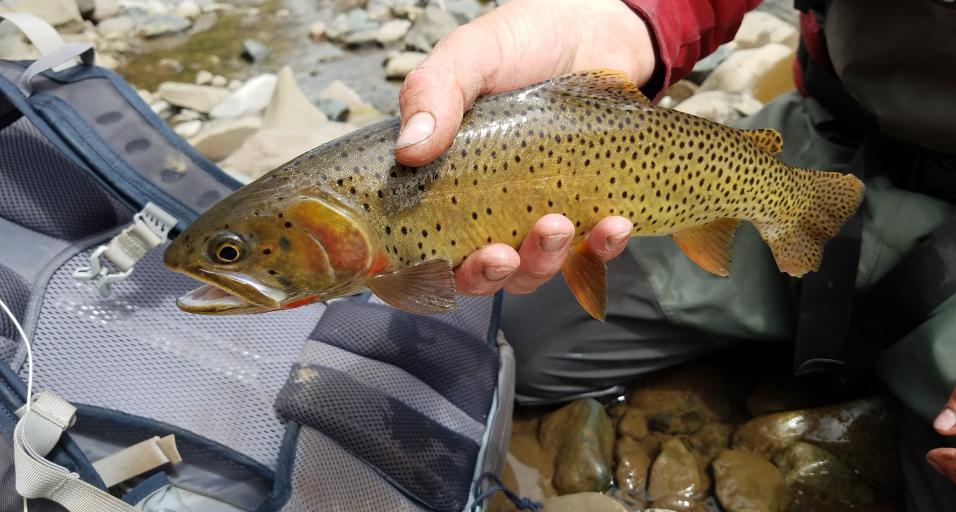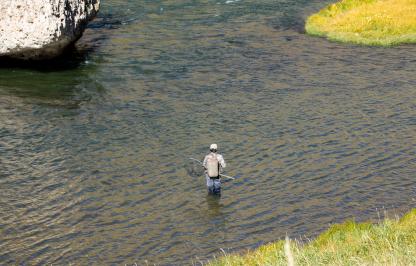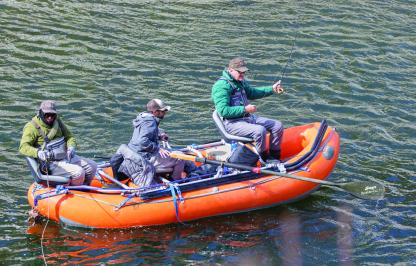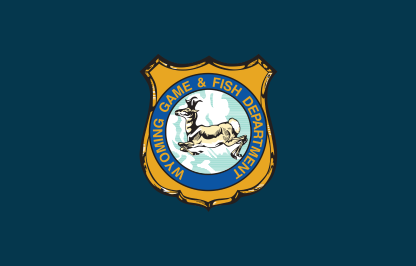In the winter of 2018, fisheries managers with Wyoming Game and Fish Department convened a collaborative working group to discuss public interests and concerns pertaining to Yellowstone cutthroat trout (YSC) conservation and restoration in the Cody Region. Two to three sets of meetings were held in each of three communities; Cody, Lovell and Worland. At the final round of meetings, participants submitted recommendations to Game and Fish for specific locations of future cutthroat trout restoration projects in the Big Horn Basin.
In follow-up, fisheries crews with Game and Fish conducted field surveys of waters recommended through the public process to determine a site’s suitability as a potential restoration area. During field surveys, biologists evaluated overall habitat quality, the existence of barriers and the existing trout population.
The following write-up provides an update on the field surveys Game and Fish conducted in 2019. (A summary of surveys conducted in 2018 can be found here.) The latest surveys conducted concluded the fieldwork necessary to move forward with drafting a conservation plan for YSC in the Cody Region. The conservation plan will be presented to the public in the spring of 2020.
Shell Creek, above Shell Reservoir
Figure 1. Map of Shell Creek above Shell Reservoir. The three markers denote barriers.
Surveys were conducted along all streams in the Shell Creek watershed upstream of Shell Reservoir. Habitat in this section of Shell Creek is of high quality and spreads across 16 stream miles with two large tributaries and four lakes; Shell Creek is 8.5 miles, Porcupine Creek is 4 miles and Buckley Creek is 3.5 miles (Figure 1 and 2). Yellowstone cutthroat trout currently occupy the upper portion of Shell Creek, including Emerald Lake, Lakes of the Rough and 1.5 miles of stream, ending at a high gradient boulder field where the stream is subsurface, but functioning as a barrier. The remainder of the drainage includes 14.5 stream miles, Shell Lake and Shell Reservoir, all in which are inhabited by brook trout. Within this area, two barriers exist below each lake creating an opportunity to extend the current population downstream with a multi-phase approach. A partial barrier exists immediately upstream of Shell Reservoir that has the potential to be made into a full barrier or used as an additional point to further parse the treatment area. Further examination of this partial barrier is needed to better understand its potential.
Figure 2. Shell Creek above Shell Reservoir. Figure 3. Barrier below Shell Reservoir.
Shell Creek above Shell Reservoir has many positive attributes that would make it a quality restoration project, which include:
- The headwaters support a conservation population of cutthroat trout.
- Multiple barriers exist throughout the area allowing for a systematic approach to removing non-native trout.
- The area contains high quality diverse habitat types of streams and lakes.
These characteristics provide a project with diverse, high quality habitat that lead to a high probability of persistence of the cutthroat population. If considered, the first phase would be to extend the headwater population downstream to the second barrier, immediately below Shell Lake. This would add 2 miles of stream and Shell Lake. The second phase would extend to or beyond Shell Reservoir. The reservoir provides irrigation water and discussions with appropriate stakeholders would need to occur prior to treatment.
Ishawooa Creek
The lower reaches of Ishawooa Creek and its tributary Yellow Creek harbor one of three conservation populations of YSC in the South Fork Shoshone River drainage. Past sampling indicated slight hybridization with rainbow trout in this drainage. Sampling was conducted on the lower reaches of Ishawooa Creek to determine species composition and collect fin clips to conduct genetic analysis of this population. Thirty fish were sampled on Ishawooa Creek near the confluence with Yellow Creek; ten of which were brown trout, 19 of which were YSC (Figure 4), and one was an obvious rainbow-cutthroat hybrid (Figure 5). The fin clips will be submitted to a laboratory to determine the amount of hybridization within this population.Figure 4 (left). A fine looking Yellowstone cutthroat trout from Ishawooa Creek.
Figure 5 (right). Rainbow-cutthroat hybrid captured in Ishawooa Creek. Note the white fin tips and spotting pattern of a rainbow trout with the distinctive cutthroat slash under the jaw.
A large waterfall barrier (see photo to left) separates fish in the lower reaches of Ishawooa Creek from the upper reaches. It’s likely these upper reaches were historically fishless. Yellowstone cutthroat were stocked in these upper reaches in 1959 and 1960, but it’s unknown if those populations persisted. Further, records of stocking rainbow trout and brook trout exist for this drainage, but the location of the stocking is questionable. Electrofishing was conducted above the waterfall barrier to determine if any fish are present above those falls. No fish were captured in the reaches above the falls on Ishawooa Creek. Water samples were also filtered to analyze for the presence of fish DNA. This sampling of environmental DNA (eDNA) is highly sensitive and can detect the presence of fish when conventional sampling is unable to detect their presence.
Much of Ishawooa Creek, above the barrier falls is high gradient and has steep canyon walls. Although the entire stream length was not walked, there were numerous bedrock outcrops that created additional barriers in the reaches that were sampled. These additional barriers fragment the habitat into smaller habitat patches and reduce the suitability of these areas for establishing YSC.
Crandall Creek
The Crandall Creek drainage upstream from the Hurricane Mesa Ranch is comprised of six notable streams: Temple, Hoodoo, Papoose, Timber, Closed and North Crandall Creeks. Collectively, these tributaries provide approximately 60 miles of interconnected habitat which supports the third largest meta-population of YSC in the Cody Region. Within these streams, cutthroat have been hybridizing with rainbow trout since the initial stocking of rainbows in 1935. Rainbow trout were stocked in six years spanning 1935 to 1955.
The primary intent of the 2019 surveys was to systematically sample Papoose, Timber, Closed, and upper Crandall creeks in an effort to determine where pure YSC exist and the extent of hybridization in each stream.
Figure 7. View from Papoose Ridge looking upstream at the Papoose, Timber and Closed Creek drainages.
Papoose Creek (7 miles of suitable trout habitat):The upper 4.5 miles of Papoose Creek are currently fishless. A barrier falls was identified approximately 2.3 miles upstream from the Papoose/Crandall confluence. Below these falls a total of 42 trout were sampled, of which 39 were YSC and three were hybrids. Habitat quality in Papoose Creek was decent with relatively few deep pools which are critical for overwinter habitat. Much of the present day habitat appears to be influenced by post-fire dynamics (see photo). Trout density was moderate.
Timber Creek (10 + miles of suitable trout habitat):
Timber Creek joins Closed Creek to form Crandall Creek. Timber Creek was sampled at three
reaches, near the mouth and 4.5 and 6 miles above the confluence with Closed Creek. Thirtythree trout were sampled from the upper reach all of which appeared to be pure YSC. Thirty trout were sampled at the lower site all but one of which were identified as pure Yellowstone cutthroat trout, the other trout showed what seemed to be low levels of hybridization. Thirtyfour trout were sampled just above the confluence with Closed Creek all of which were determined to be pure YSC. Timber Creek had high quality habitat with fairly high densities of trout. This drainage seems to have very low levels of hybridization with rainbow trout.
Closed Creek (8 miles of suitable trout habitat):
Closed Creek was sampled at locations, just above the confluence with Timber Creek, 1.7, 3.5
and 4.5 miles upstream from this confluence. A total of 96 trout were sampled across these four
sample sites. A majority (91) of the fish sampled were identified as YSC with four trout
identified as rainbow-cutthroat hybrids and one rainbow trout. Hybrid trout were found at the
lowest three sites sampled on Closed Creek. Yellowstone cutthroat trout represented 94%, 82%,
97% and 100% of the trout sampled at sites one through four respectively.
Crandall Creek (9 miles of suitable trout habitat):Crandall Creek mainstem from the confluence of Closed and Timber Creeks downstream to the partial barrier below Highway 296, provides high quality trout habitat. A total of 64 trout were sampled in the upper most mile of stream of which 60 were YSC and four were hybrids.
In general, the surveys found hybrid trout to be present at low densities in the lower end of each tributary. Past surveys of lower Crandall Creek found that 34% of the trout population was comprised of rainbow trout. The finding of over 90% pure YSC in the headwater streams indicates that the mainstem of Crandall Creek is the primary source of rainbow trout and hybrids. Removal of the rainbow and hybrid trout from the mainstem of Crandall Creek will be important to prevent further hybridization and is necessary for the long-term conservation of this large interconnected population of YSC.
(Photo above) Figure 9. Closed Creek flows through several bedrock outcrops providing deep plunge pools. Quality habitat was present, but trout densities seemed to vary from low to moderate throughout this stream.




